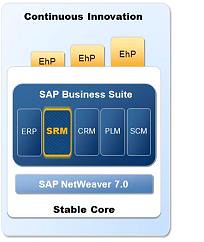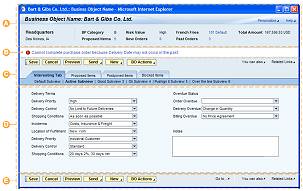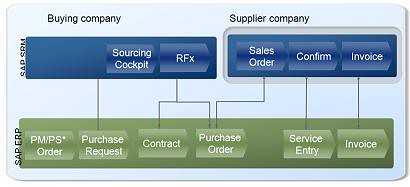
- SAP Community
- Products and Technology
- Additional Blogs by SAP
- SRM 7.0 in the Business Suite
- Subscribe to RSS Feed
- Mark as New
- Mark as Read
- Bookmark
- Subscribe
- Printer Friendly Page
- Report Inappropriate Content
SRM 7.0 in the SAP Business Suite
SRM 7.0 is scheduled to be released in Q4 as part of the SAP Business Suite release. The Procurement vision remains the same - to be an integrated sourcing and procurement platform that supports purchasing as a strategic value contributor to the business - but the delivery model will change with the Business Suite release. The Business Suite will draw on the core strengths of SAP Supplier Relationship Management (SRM) and ERP Materials Management (MM) to deliver the Procurement vision.
Procurement Platform – Stable Core
SRM 7.0 will deliver a stable core (software architecture and ESOA services) on which customers can extend the functionality. SAP will provide additional Procurement functionality to the core through optional enhancement packs, which will provide customers with the latest technology and business processes without a costly upgrade. In other words, there are no foreseeable plans for SRM 8.0, but there is a long-term roadmap that delivers new procurement features and functions through a series of enhancement packs.
If we take a look at traditional software delivery, an upgrade requires an "all or none" deployment and thorough testing. By contrast, in the enhancement pack model, customers can pick and choose the functionality they want to deploy using a switch framework to "flip the switch" on the functionality they want to deploy. Thus, customers can target the functionality that provides the greatest benefit to their business. In addition, the enhancement packs are lightweight and isolated testing reduces the testing effort for customers.
From a development perspective, the Business Suite concept enables Procurement to leverage functionality that is in the suite. For Procurement, the main contributors will be SRM and MM. MM has a long successful history in tactical processes, including subcontracting, complex services, material planning, and industry-specific processes to name just a few. SRM, on the other hand, has delivered simplified user interfaces, supplier collaboration, centralized purchasing, and strategic purchasing functionality, such as sourcing, contract management, supplier management, and spend analytics. Future development will leverage SRM’s and MM’s core capabilities to deliver complete and integrated Procurement scenarios to customers. Accordingly, the Business Suite, with the inherent enhancement pack approach, will enable SAP to bring innovative Procurement features and functions to market more quickly.
New in SRM 7.0
The following are some key developments in the first SRM 7.0 release that demonstrate the Business Suite concept. This is not an exhaustive list of new functionality (more to come in future blogs).
ERP and SRM Harmonization
The challenge in coupling processes from two different applications, SRM and MM, is an inconsistent user interface depending on the application serving the process step. To address that challenge, the applications now follow a consistent and streamlined floor plan that achieves a consistent look and feel throughout the process. We worked with our customers’ end users to develop these floor plans for objects, quick activities, and guided procedures and further tested the user interfaces with our customer influence groups. The new user interfaces streamline user interaction with the system by mitigating the number of clicks and reducing scrolling.
Not only did we achieve a consistent look and feel across procurement processes, but also we consolidated business objects to a single screen to streamline processes for the purchasing role. Purchasers can now search and access all their business documents, such as ERP and SRM purchase orders, on a single, customizable power list called a Personal Objects Work List (POWL). On the POWL, users can define their workspace by assigning documents, and creating various queries and views. As proof to the power of the POWL, 8 steps of a 12-step use case to create a purchase order can be performed on the single POWL screen.
Service Procurement
The Service Procurement development in SRM 7.0 is a prime example of how SRM and MM can come together in the Business Suite to enable a process. In SRM 7.0, the focus for Service Procurement development is complex services procurement – more specific, planned maintenance and construction scenarios. The specification for these complex services is often captured in a service hierarchy. The Services module within MM (MM-SRV) does a very good job of enabling a requisition-to-invoice process for these complex services. Moreover, SRM 7.0 brings sourcing and supplier collaboration capabilities to the process, as well as a catalog repository for the hierarchical service specifications. Thus, as the picture shows, SRM enhances the MM-SRV process as bidders will be able to bid on the detailed service specifications, and winning suppliers will be able to create service entry for the detailed specifications in Supplier Self Services (SUS) (among other functions).
Central Contract Management
SRM 7.0 will also deliver a central contract repository for procurement contracts. The central contract repository will leverage the SRM contract capabilities, such as hierarchies, discounts, and versioning, and make contracts available as a source of supply in SRM and ERP. All information related to the contract, such as contract call-offs and recognition of rebates/discounts, can be accessed centrally in the central contract repository. It is worth noting that this is not the same as Contract Lifecycle Management, which provides the legal contract authoring functionality and central contract repository for all contracts. Central Contract Management in SRM 7.0 refers to the outline agreement that is used to achieve compliance in the operational procurement process.
Sourcing Enhancements
As mentioned above, one of SRM’s core contributions to the Business Suite is Sourcing, which has been developed in SRM for some time. Accordingly, purchasers can leverage that development from ERP. Purchasers can start a RFx process in SRM directly out of ERP, either through the Sourcing Cockpit or by directly creating a bid invitation. All related information to that request, such as status, can be accessed in ERP. Stay Tuned
There are a number of topics I did not cover in this blog, such as Spend Analytics, ESourcing, Contract Lifecycle Management, deployment, technology, and a significant number of new Procurement core features. Stay tuned because we will cover some of the additional functionality in future blogs. Further information will also be available in the SAP Service Marketplace (http://service.sap.com/srm), such as Delta, Overview (Level 1), Feature/Function (Level 2), and installation/configuration presentations.
- Start page of SAP Signavio Process Insights, discovery edition, the 4 pillars and documentation in Technology Blogs by SAP
- SAP Integration Suite - IDOC to flat file conversion in Technology Q&A
- Equipment/Functional location Manufacturer Serial number --> Order --> PR in Enterprise Resource Planning Q&A
- Consuming SAP with SAP Build Apps - Mobile Apps for iOS and Android in Technology Blogs by SAP
- Bill Of Material need to show in tree structure into BoM Screen SAP B1 in Enterprise Resource Planning Q&A



